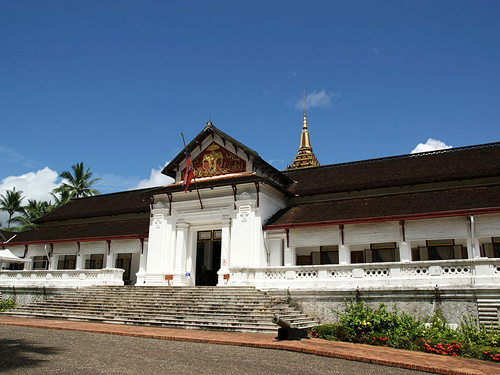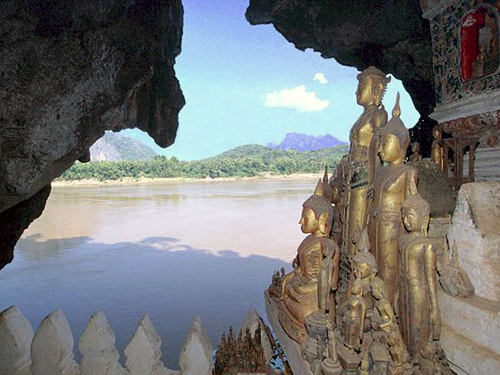Formed at the convergence of the famous Mekong and Kahn rivers in Laos, the town of Luang Prabang is the archetypal product of when colonial and traditional architecture collide. Groomed in pristine fashion, one would think he is the first to discover this exotic landscape.
Palm trees line the riverside, as the spires of divine stupas protrude through the trees, and all while in the company of Buddha’s servants.
Above ground level, the views will take your breath away as the landscape proudly shows off its mountainous terrain. As you weave through hiking grounds blessed doused in nature’s beauty, one cannot help but act with acquiescence as you discover serene tropical nooks and tranquil waterfalls.
Palm trees line the riverside, as the spires of divine stupas protrude through the trees, and all while in the company of Buddha’s servants.
Above ground level, the views will take your breath away as the landscape proudly shows off its mountainous terrain. As you weave through hiking grounds blessed doused in nature’s beauty, one cannot help but act with acquiescence as you discover serene tropical nooks and tranquil waterfalls.

Luang Prabang is a place where sights, sounds and curiosity guide your adventure , and when it’s all said and done, and you’ve moved on, yields a memory you will never forget. Below are a few places you won’t want to miss seeing.
Vat Xieng Toung
One of the more popular sites in Laos, Vat Xieng Toung (Temple of the Golden City) also serves as one of the country’s most important landmarks, having been built by King Setthathirat in the 16th-century supposedly on the site where the first stone was lain in the newly founded Luang Prabang.
Today, the temple resides surrounded by a majestic garden along the Mekong River. It is ornamented by a gilded door, mosaics, and stories etched in gold leaf telling the tale of the now-famous Laotian town.
Today, the temple resides surrounded by a majestic garden along the Mekong River. It is ornamented by a gilded door, mosaics, and stories etched in gold leaf telling the tale of the now-famous Laotian town.
Haw Kham Royal Palace
The other major historical building in town is Haw Kham Royal Palace (Golden Hall) formally that of King Sisavang Vong and his heirs before the monarchy was abolished during the height of communism. Today a statue of the king adorns the palace grounds, as well as the palace’s most important statue, the Pha Bang Buddha image, made almost entirely of pure gold.
The other major historical building in town is Haw Kham Royal Palace (Golden Hall) formally that of King Sisavang Vong and his heirs before the monarchy was abolished during the height of communism. Today a statue of the king adorns the palace grounds, as well as the palace’s most important statue, the Pha Bang Buddha image, made almost entirely of pure gold.
Built in both French and Laotian style architecture, the palace takes on the shape of a cruciform and inside provides arts, paintings, statues, and murals of traditional Laotian life, and history, and of course, symbolizes the lives of Laotian royalty.
For an added bonus, make your way to the top of Mount Phousi, where you can take in perhaps the greatest view of the palace.
Tat Kuang Si Waterfalls
For all that is great about the town of Luang Prabang, the allure of this most beautiful destination is not just in its history and architecture, but its nature as well. Located about 19 miles (30 km) from town lies the Tat Kuang Si waterfalls, a virtual paradise away from civilization.
You can hike the multi-tiered falls and take a dip in the blue waters at your leisure just be careful, it is quite cold. Along your way, stopover at the sun bear sanctuary, where caretakers watch over bears saved from poachers.
Pak Ou Caves
One of the most interesting and unique natural locations in the area are the Pak Ou Caves. Located about 15.5 miles (25 km) north from town, the caves reside over the Mekong, and are well-known for their diversely positioned Buddha sculptures, overlooking the river. (The sculptures were donated by the local population as the caves were once used as a shrine.)
The caves are categorically divided into two levels, the lower (Tham Ting), located about 50 feet (15.24 m) above water level, and the upper (Tham Theung), which without a flashlight is extremely difficult to navigate. Once you are able to climb your way into the upper level, light a few candles surrounding the shrines and observe the almost quixotic beauty of Buddha silhouettes formulated on the cave walls.
The entrance to the caves is easily spotted and is accessible from the riverside. The most practical and scenic way to get to the caves is by boat from Luang Prabang, although a newly built road from town can also get you there.
>> Trekking to Pak Ou cave
Source: travelleradvise





0 comments:
Post a Comment